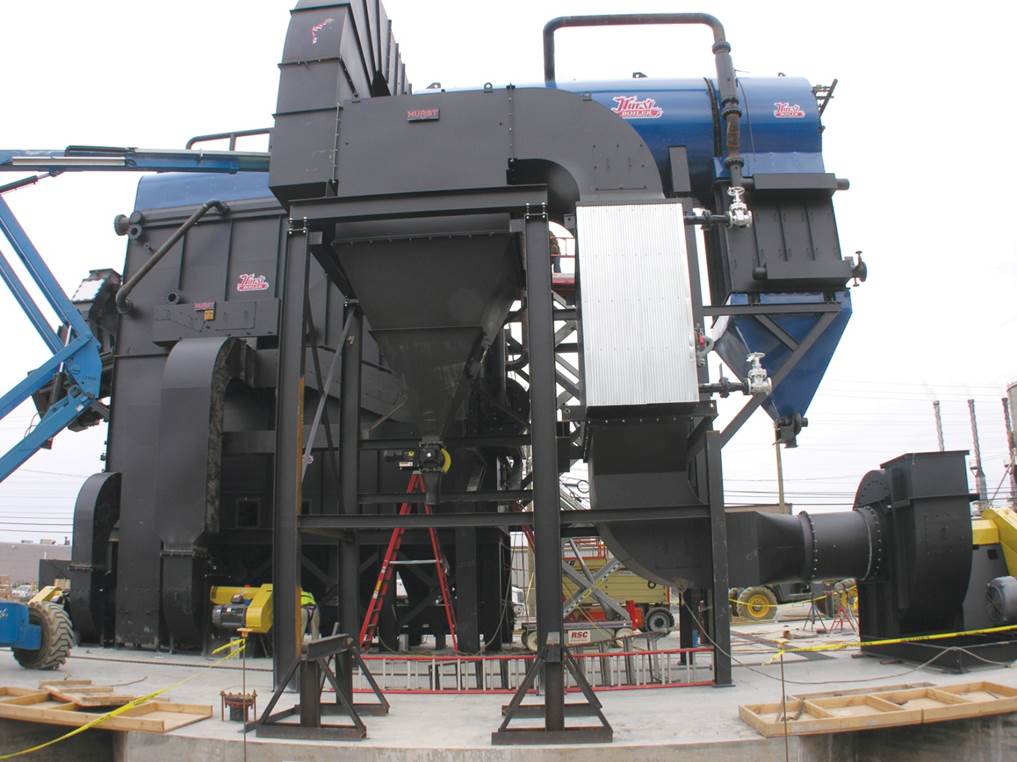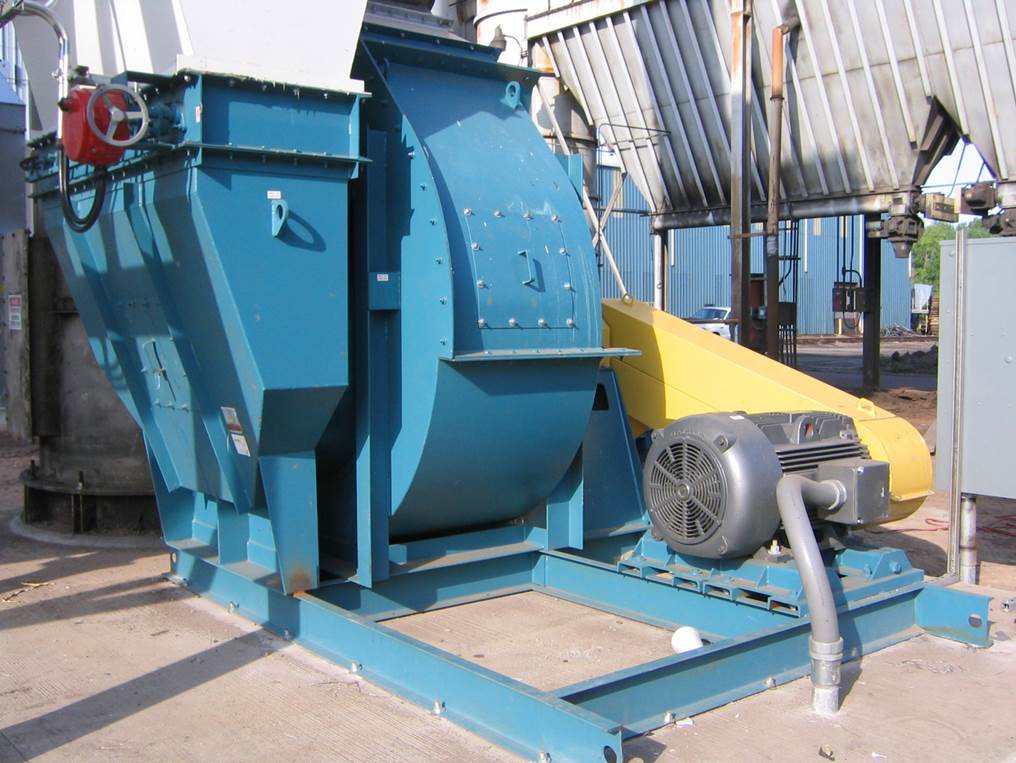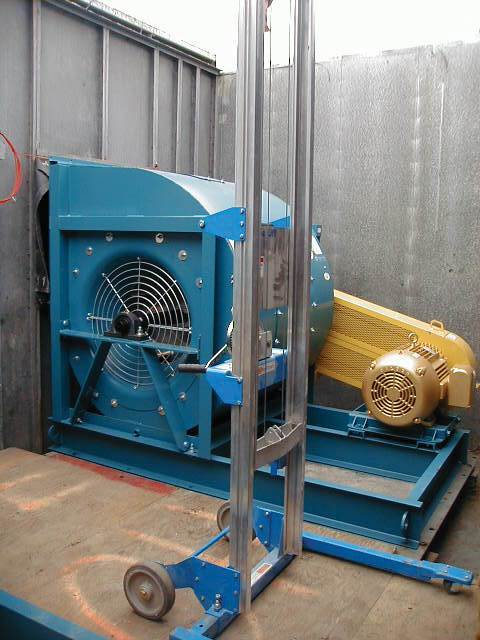Overview
Hurst Boiler was looking for a partner that could provide the fans needed for their biomass boiler packages. Because these boiler packages range in size and temperature capabilities, often producing extremely high temperatures, rugged construction and flexibility were important considerations in selecting a fan provider. They soon found that Twin City Fan & Blower was able to meet those needs—with a range of fans that provided the flexibility they needed and the high-quality, durable construction that this application demanded. Since then, TCF has continued to meet those needs, providing the underfire combustion air fans, overfire air fans, and induced draft fans needed to run the biomass boilers. Quality products—combined with the above-and-beyond customer service that TCF consistently provides—has made Hurst Boiler a loyal customer for more than twenty years.
Challenge
Hurst Boiler manufactures biomass boiler packages, ranging in size from 150 HP up to 2,000 HP, capable of reaching temperatures as high as 1850°F. This application presents a variety of challenges to the fans that must not only keep the fires going, but draw the air through the boiler package and into the steam chamber, collector, and eventually up through the stack and into the atmosphere. With a range of sizes and temperatures, Hurst Boiler needed a partner with the flexibility of a full complement of fan sizes and capabilities, and high-quality manufacturing that could stand up to a harsh operating environment.
Solution
Hurst Boiler chose to partner with Twin City Fan to provide the underfire combustion air fans, overfire air fans, and induced draft fans needed to run the biomass boilers. Depending on the size of the boiler, the fuel which needs to be burned, and the temperature at which it will operate, TCF specifies the appropriate fans to get the job done in the most efficient, and effective way possible. With the flexibility that comes from having a full line of fans, and a history of manufacturing high-quality, innovative products, Twin City Fan & Blower easily accommodates all of Hurst Boiler’s biomass boiler fan needs.
Traditionally, the AMCA-certified Twin City Industrial Radial Blade Fan, and the RBO Series, constructed with a radial paddle wheel, has been used for the induced draft fan. The RBA Series, constructed with a radial air handling wheel, have been used for the underfire and overfire air fans.
Under- and overfire systems are sized to handle temperatures in the 200–250°F range, so a standard fan is generally used—producing anywhere from 1,500 CFM at eight inches of static pressure to 15,000 CFM at 12 inches of static pressure.
The induced draft fan generally produces a much higher CFM, ranging any where from 8,000 CFM to 60,000 CFM; with static pressures from 10 inches to 30 inches, depending on what fuel is used in the individual boiler system.
The RBA industrial radial air handling wheel, constructed with heavy-gauge blades welded to both the backplate and the front ring is very efficient—and is designed to handle temperatures ranging from 350°F to 500°F. Due to the potential for buildup on the blades from material coming through the fan, it utilizes a straight radial blade design, helping alleviate potential operational problems.
The RBO industrial radial paddle wheel is also extremely rugged, and uses heavy-gauge steel components which are jig assembled for accuracy and consistency. All wheels are carefully welded to ensure maximum strength
and reliability—a critical requirement for boiler applications.
For larger boilers—those that require upwards of 2,000 HP—TCF typically specifies the radial tip fan RTF or HRT series, which utilize a radial tip blade, allowing for better fan efficiency and therefore lower HP than the RBO or RBA series which are used for the smaller boilers. The radial tip fans utilize a heavy-duty rugged design, suitable for applications involving large volumes of gas streams at moderate to high pressure, like those of the biomass boilers. In addition, radial tip fans offer high efficiency, lower first costs and operating costs, and statically and dynamically balanced rotor assembly.
The HRT is purposely engineered for higher specific speeds, offering a high efficiency selection across a wider range on the fan curve, with a peak static efficiency reaching 77%.
In some instances, a cast iron series CIW reinjection fan is used to reinject air back into the system to allow the boiler to fire better—utilizing a cast iron direct drive to handle the ambient air most effectively. This hearty, well-built fan is perfectly suited to the needs of certain boiler packages—in these cases, one to three series CIW reinjection fans may be added into the system to help produce optimal results.
The bottom line? Twin City Fan is well-equipped to provide fans with a wide range of capabilities: suitable for small to large systems, average to high temperatures, and clean or dirty airstreams.
Benefits
Rugged Construction
Biomass boiler packages service the wood industry—burning waste products ranging from excess wood, wood chips, coconut husks, or even cocoa bean shells to create steam that can then be used to generate power. Fans serving these types of industrial applications need to have a rugged construction to be able to handle the harsh operating environment introduced by the high-temperature biomass boilers, and TCF fans continue to stand up to the test. All housings are continuously welded using heavy gauge, reinforced steel, and suitably braced to prevent pulsation. Wheels and blades are manufactured with a heavy-duty, robust design.
In addition, the range of products used in the boilers means that the fans must handle often-dirty airstreams. In these cases, straight radial blade designs are used to alleviate the potential operational problems that can be caused from buildup on the blades from materials coming through the fan.
Says Bruce Coffee, Chief Engineer at Hurst Boiler, “We like that they’re very well-built. They’re built to be strong and are just very, very tough. More than 95% of those we’ve ever had in service are still going strong with the original wheel; and beyond the standard bearings and lubrication, not very much maintenance is required.”
Flexibility
With help from Hurst Boiler to determine the location, necessary orientation of the fans, and the types of materials which will be used in the boilers, TCF was able to make a recommendation on which fans will best meet the needs of the application. TCF has a full range of fans, both standard and custom, to meet any number of customer needs— including the often aggressive needs of the boiler industry.
Twin City Fan also understand the importance of designing a product that could meet the needs of varying climates and other environmental challenges. Hurst boiler systems are prolific throughout the word, from varying climates in South America, Europe, Canada, and all throughout the U.S. TCF fans are designed to meet these environmental challenges—sometimes using precipitators or other strategies when appropriate to ensure uninterrupted, consistent operation.
Superior Customer Service
Part of what has made the partnership between Twin City Fan and Hurst Boilers so successful has been TCF's and Derek Embody & Company's commitment to providing the best possible customer service. Says Coffee, “Really the best thing about Twin City Fan is the customer service.
They bend over backwards to make sure we stay happy—and they’ve really done a great job.”
Whenever possible, TCF tries to supply standard components—like a standard motor —in order to provide customers with the best, most cost-effective solution. Other simple customizations—like adding a standard nameplate or changing the location of the conduit box, help demonstrate TCF’s dedication to 100% customer satisfaction.
With a belief that an integral component to good customer service is a dedication to quality, Twin City Fan also has a comprehensive quality checklist in place. From careful selection, and ending with a complete test run before shipment, TCF strives to ensure the utmost quality and durability.
Summary
The quality and flexibility of the Twin City Fan, combined with top-notch customer service, has made Hurst Boiler a long-term, loyal customer. The relationship with customers —and a sincere dedication to their satisfaction—helps set TCF apart. We’re able to deliver a quality product at a reasonable price and consistently provide quality service. By shipping the product on time, providing knowledgeable factory and inside sales support, and maintaining a focus on providing high-quality, innovative products, TCF maintains a positive standing as an industry leader.




